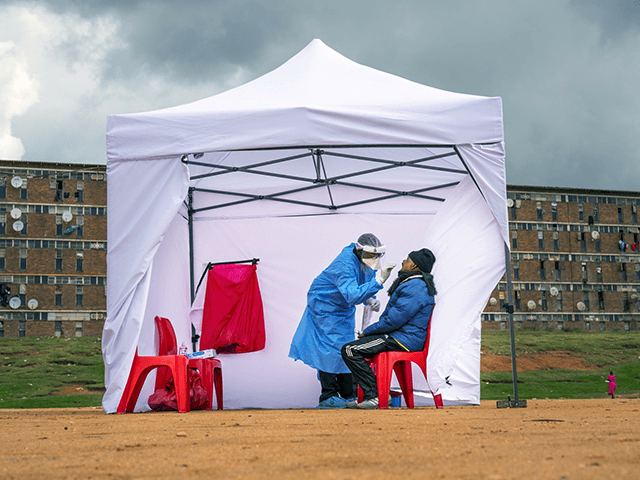The World Health Organization (W.H.O.) revealed in its weekly report published Tuesday that a significant spike in documented Chinese coronavirus cases around the world did not correspond to an increase in deaths attributed to coronavirus infections.
The W.H.O. noted that studies indicated a plurality of documented coronavirus cases were of the omicron variant of the disease, potentially originating in Europe but documented first in South Africa, and the vast majority of the rest were of the older delta variant originating in India. Infections of the alpha version of the coronavirus – the first iteration of the novel disease originating in Wuhan, China, in late 2019 – were down to less than 0.1 percent of cases.
The weekly report said:
Globally, during the week 3 – 9 January 2022, the new weekly COVID-19 [Chinese coronavirus] cases increased markedly by 55%, while the new weekly deaths remained similar to those reported during the previous week. This corresponds to over 15 million new cases and over 43,000 new deaths.
“As of 9 January, over 304 million confirmed cases and over 5.4 million deaths have been reported,” the report asserted.
The W.H.O. noted that Africa had documented the only decrease in cases of any region in the world, down 11 percent from the week before. Africa documented an 84-percent increase in deaths week-on-week, however, suggesting a lag time between diagnosis of coronavirus infection and death as a result.
The report noted that America documented more new cases than anywhere in the world week-on-week, a 73-percent increase from the week before. India and several European countries occupied the top five spots. The W.H.O. per-country assessment of cases and deaths is fundamentally flawed, however, by its reliance on countries reporting their own numbers. Evidence suggests that rogue states like Iran, Russia, and especially China have throughout the pandemic reported artificially deflated numbers of cases and deaths. As early as December 2020, Russian authorities admitted to depressed numbers showing as little as a third of actual coronavirus cases. In Iran, independent estimates from dissident groups indicated that hospitals were largely undercounting cases and hiding deaths while morgues were overwhelmed with bodies.
China may currently have the largest coronavirus outbreak in the world, but it has locked down tens of millions of people and regularly persecutes journalists attempting to expose the reality of the situation there. At the height of the first wave of the pandemic in early 2020, China admitted to simply omitting “mild” coronavirus cases from official tallies.
Even pseudo-democratic countries have struggled with accurate case counts. A study published last week suggested the Indian coronavirus death toll was around 3 million people, or six times the government’s estimates.
Elsewhere in its report, the W.H.O. built upon preliminary reporting suggesting that the omicron variant of coronavirus does not cause severe disease and death as often as prior iterations of the pathogen. In addition to the sustained death rates, the U.N. agency cited several new studies adding to the current body of evidence that this is the case.
“In terms of disease severity, there is growing evidence that the Omicron variant is less severe as compared to other variants,” the weekly report stated. “A non-peer-reviewed preprint from Gauteng province, South Africa [found] … [d]espite the higher number of cases during the ‘Omicron-dominant’ period, hospital admission rates were lower, with 4.9% of cases admitted as compared with 18.9% admitted during the ‘Beta-dominant’ period and 13.7% during the ‘Delta-dominant’ period.”
The beta variant originated in South Africa and spread somewhat slower than delta and significantly slower than omicron. As the origin location for the variant, however, South Africa sustained significant numbers of beta infections even as the virus failed to spread around the world.
The study also found, the W.H.O. detailed, that “patients admitted during the ‘Omicron-dominant period’ were 73% less likely to have severe disease than patients admitted during the ‘Delta-dominant period.'”
That result is consistent with a similar study from South Africa’s National Institute for Communicable Diseases (NICD) released last month finding that omicron variant patients were about 80 percent less likely to be hospitalized compared to alpha, beta, and delta. The South African Health Ministry had at the time documented that hospitals had received 11 times fewer patients compared to the most recent delta variant outbreak.
South African scientists confirmed the existence of the omicron variant in November. By the end of December, authorities reported that they believed the peak of the omicron wave was beginning to subside.
“All indicators suggest the country may have passed the peak of the fourth wave at a national level,” the South African government said in a statement that month. “While the Omicron variant is highly transmissible, there has been lower rates of hospitalization than in previous waves.”
American medical professionals have reported evidence similarly leading them to conclude that omicron causes less severe disease.
“We’ve seen cases and test positivity increase sharply, but, as yet, we have not seen the same thing with respect to the markers of severe disease, particularly hospitalizations,” Dr. Dave Chokshi, the health commissioner of New York City, said in December, as cases rose dramatically in the urban center. “Right now, there are about a thousand people hospitalized with COVID-19 [Chinese coronavirus] across New York City, that’s about a quarter of where we were at the peak of last winter’s wave and less than a tenth of where we were in the spring of 2020.”

COMMENTS
Please let us know if you're having issues with commenting.